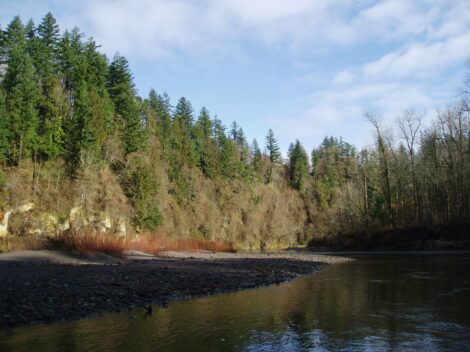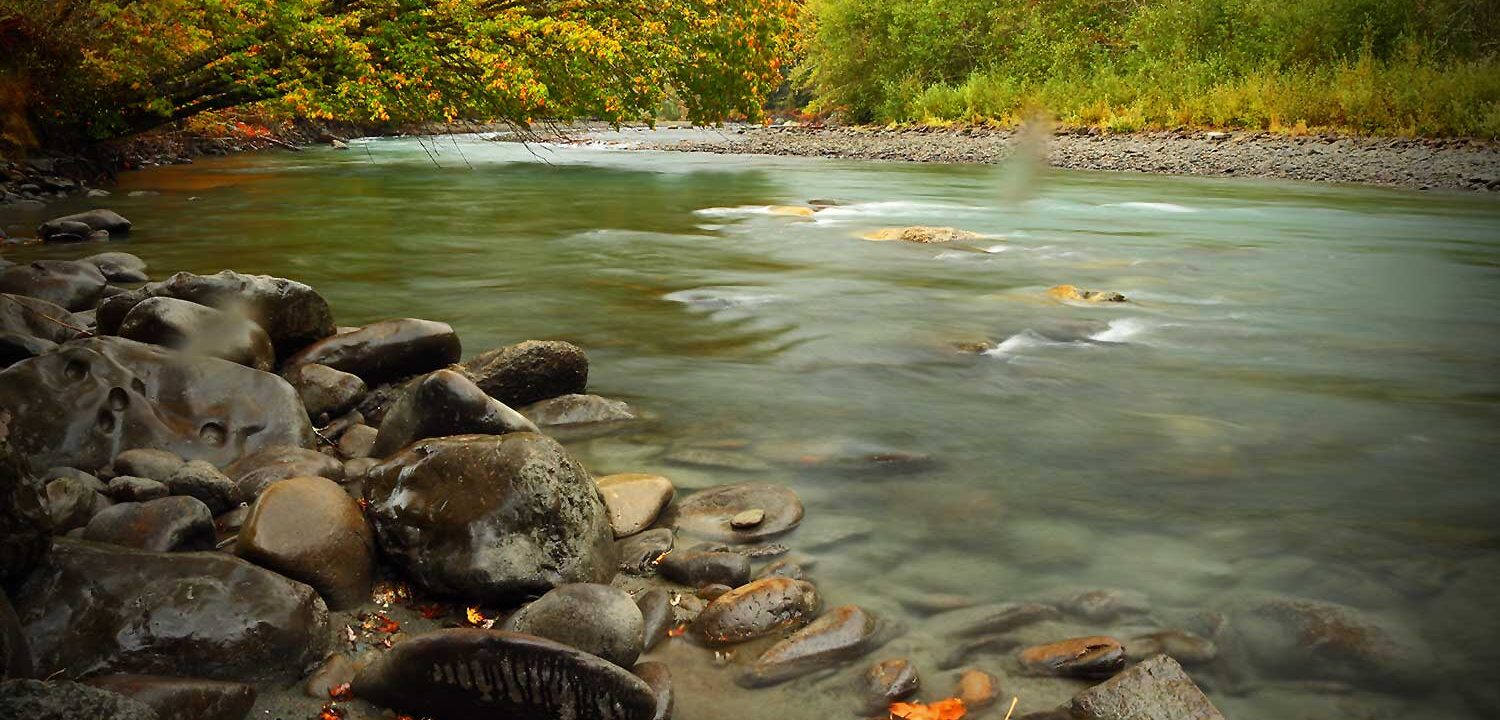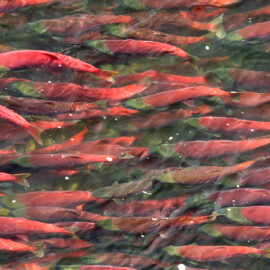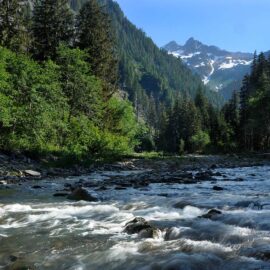Notes from the Field: Highlighting dam removal and salmon habitat restoration in the Pacific Northwest.
Hiking through the tall firs and hemlocks of the Olympic Peninsula in the far northwest corner of Washington, the silence is broken by the faraway rumble of heavy equipment. Walk on, and you hear the beep, beep, beep of backup horns, the screech of ripping metal and the crunch of pulverized stone. At any other time over the past century in the Pacific Northwest, this dreaded chorus would have meant only one thing: This perfect forest, this beautiful, free-flowing river full of salmon, was being dammed.
But this is not the Pacific Northwest of a century ago. This is a new place, a new more environmentally conscious time, and the construction noises you hear hiking alongside the Elwha River and headed deeper into the Olympics are not the sounds of destruction, but rather deconstruction, dam breaching, and most of all, recovery. As you round a final twist in the trail, what you discover is not a high wall of concrete, a hydroelectric dam, but a river that has been cut loose, freed, a river being restored to it’s natural state.

This is the new century’s environmental story of the Pacific Northwest – and perhaps beyond. As the past 50 to 100 years were dedicated to dam building and hydropower, many here predict that the next 20 to 30 years will be about returning rivers to their natural flow. Historians may date the start of this change to 2007, with the decision to begin destruction of the Marmot Dam on the Sandy River outside of Portland. (Featured in this magazine last year). The Marmot, like many aging dams in the Pacific Northwest, was due for relicensing. Its owner, the utility company PacifiCorp, saw clearly that the enormous costs of bringing it to modern standards, with safe fish passage, were far greater than the costs of taking the dam down.
Marmot Dam was the first major U.S. dam to be removed using what’s been called the “blow and go” system of dam removal – blasting the dam with explosives and allowing the sediment behind it to wash downstream. Skeptics, including those who opposed dam removal, warned that the deep sediment that had built up behind the dam would badly damage the river and harm native aquatic species. In fact, after the dam was removed, the approximately 1 million tons of sand and gravel were washed away in a matter of months, showing the true power of a natural river. Said John Esler, one of the dam removal project managers for Portland General Electric, the utility that owned it: “The main concerns about sediment blocking never materialized. We had Coho spawning the next week. Literally. It was amazing. You could stand up on the bridge, look downstream, and feel like you were looking at a river in the Olympic Peninsula.”
As this story was being written, wild winter steelhead were passing the old Marmot Dam site and headed up the Sandy River, traversing the 100 or so miles of newly opened river, and beginning to occupy tributaries that had been void of steelhead for almost a century.
“This is a grand experiment that came out just like people hoped it would,” said Esler.

The successful breaching of the Marmot Dam was the opening that fishing and conservation groups were looking for. In the newly free-flowing Sandy River, they saw the future of many other streams and rivers in the Pacific Northwest. They saw rivers bursting free and wild, and wild salmon and steelhead returning to areas that have been devoid and empty of their species for decades.
“The river restoration movement in our country is stronger than ever,” said Serena McClain, director of the River Restoration Program for the conservation group American Rivers. “Communities nationwide are removing outdated dams because they recognize that a healthy, free-flowing river is a tremendous asset.”
The Marmot Dam was the beginning. The ripple effects are still spreading across the Northwest. After decades of seeing dams almost solely for what they provide in terms of electricity and flood control, more people in the Pacific Northwest are taking a harder, critical look at the damage they can cause. Dams block precious spawning habitat to salmon and other species. They negate water quality. They create warmer water temperatures downriver, allow toxic algal blooms in reservoirs, decrease needed dissolved oxygen levels in the water, and limit the creation of natural and critical floodplain habitat. Sediment loads up behind dams, but is lost downstream. All of the particles carried in the water, everything from sand-sized to boulder-sized, would naturally make their way downriver, being distributed evenly and naturally throughout the whole river and into the estuary. With these particles blocked, the river below the dams is starved of sediment. The river bottom is scoured down to the bedrock, erasing spawning areas for adult salmon, and critical habitat for many other species.
In the Pacific Northwest and around the world, generally there are two kinds of dams: run-of-river dams, and impoundment dams. Run-of-river dams use the normal flow of the river’s current to create electricity. These dams require water running through the turbines to create power and don’t require reservoirs. The impoundment dams are the most common hydroelectric dams in the world and require large amounts of stored water – reservoirs – to allow for year-round production. They are the most destructive dams.
This fall I hiked up to the Elwha Dam and took pictures of the decommissioning of the dam. Upstream, the Glines Canyon Dam also was being removed. Together, these projects amount to the largest dam removal effort in U.S. history. Though actually removing dams can seem daunting, the Pacific Northwest has demonstrated that the engineering and ingenuity is available. The more difficult challenge is weighing the value of the dams versus the harm to salmon and the rest of the environment – and then getting decision makers to act when the balance does swing to dam removal.
Even though the clean, coal-free electricity created from hydropower is important, sustaining and rebuilding our salmon runs is even more vital.”
The Glines Canyon Dam is representative of the dam removal projects under way in the Pacific Northwest. Tucked inside a nearly vertical canyon, the dam was 64 meters tall. When removal was planned, again one of the main problems was the amount of sediment stacked up behind the dam, and the steepness of the river canyon walls on both ends, also covered by this sediment. By simply tearing the dam down, sediment would pour down the canyon, and the river would cut its way through the backed up sediment. But what occurs if the new river path doesn’t follow the older path? The riverbanks would be steep and prone to slides. Each time a slide would occur, more sediment would pour into the river, creating a hazardous environment for the fish species, and possibly blocking the river’s path.
Dam-removal engineers and scientists together came up with a solution. To start, they would use machines to cut a pilot trench for the river to follow, which followed the old river’s path. Next, instead of removing the dam all at once, they would remove the dam 15 feet at a time. By doing this, they would allow the river to reach an equilibrium after each step. This method allowed them to harness the power of the river for sediment diffusion, and create a safe, secure, controlled method of both removing the dam, but also allowing the sediment to successfully drain out, and the river to regain its natural path.
Far from the Elwha River, other Pacific Northwest dams also are coming out. Several small dams on Oregon’s famed Rogue River have been breached, and now the Rogue runs more than 100 miles free to the sea. In October, crews set a charge to 700 pounds of dynamite and blew open a tunnel in the base of Condit Dam on the White Salmon River in Washington. It was a spectacular scene, watched on live web broadcasts all over the Pacific Northwest, tons of sediment and water blasting through the dam and careening downstream. When the dam is cut apart and removed, salmon and steelhead will have access to dozens of miles of some of the best fish habitat in the region – spawning areas that they have not been able to reach since 1913.

As more and more dams come down, the ripple effect will only get stronger. The pressure will grow to breach more dams that clearly do more harm to fish than the good they provide in electricity production and flood control. There is strong support for a negotiated plan worked out by PacifiCorp, the states of Oregon and California and many interest groups for the breaching of four dams on the Klamath River, once one of the strongest salmon runs on the west coast of the United States. The Klamath has been in the center of many battles throughout the years over scarce water, a sick river and battered salmon and steelhead populations. Given the broad agreement in the region, and the support of the Obama administration, there’s every reason to believe the four Klamath dams may be removed by 2020. Again, the Northwest would be the site of the largest dam removals ever to take place in the United States.
There’s no telling where the ripples will spread, and how far they will go. Will it reach the large Snake River dams, which would throw wide open the thousands of river miles of salmon spawning territory in Idaho? With the rest of the world watching what is happening in the Northwest, could the ripple effects be large enough to invoke a movement in faraway places? Could we be seeing a transformation in areas such as the Russian Far-East, where there are already plenty of dams that offer few benefits, but clearly damage salmon runs? “There’s global interest right now in river restoration,” said Gordon Grant, a research hydrologist with the U.S. Forest Service’s Pacific Northwest Research Station. He has studied the dam removal and given presentations on the results at conferences in Italy, China and other nations.
But it’s vital that fishermen and others who care deeply about wild salmon and steelhead pressure decision makers to turn interest into action. When asked why so many previous salmon restoration efforts have failed, Guido Rahr, president of the Wild Salmon Center, said: “I argue that most salmon restoration efforts have failed so far because they were implemented only after salmon stocks reached low levels of abundance.” People around the world need to act in a timely manner, take notice of what has been happening in the Pacific Northwest and begin to act before it is too late.
The Northwest has made a stand. Even though the clean, coal-free electricity created from hydropower is important, sustaining and rebuilding our salmon runs is even more vital. Hiking through the Olympic forests along the Elwha, you can hear the rumble of that change rippling through the Northwest. Just as a century ago, it’s the sound of progress. But this time, it’s the sound of another dam coming down.




